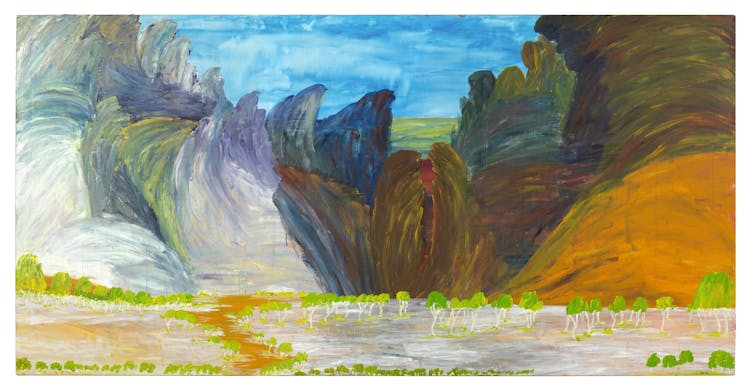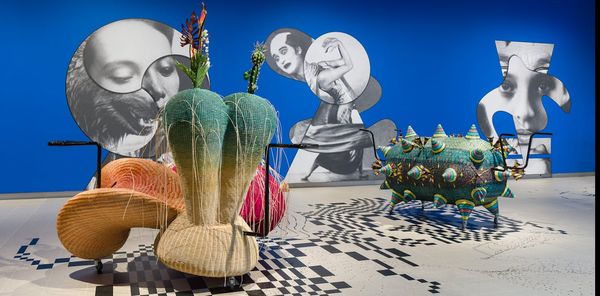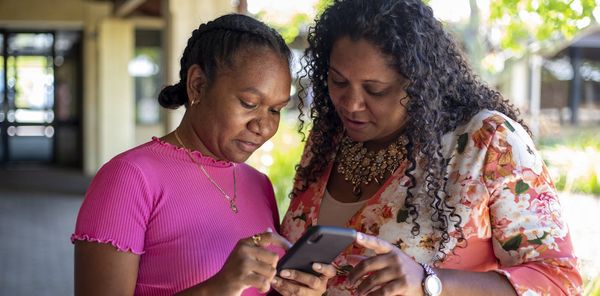The third section of the Uluru Statement from the Heart is Truth. Without knowing the truth of the history of Australia’s Indigenous people, and how the European invasion continues to impact on them, it is hard to understand the pain behind the loss of The Voice referendum and the ongoing need for treaties.
Marcia Langton and Judith Ryan are truth tellers. Their book 65,000 years: A Short History of Australian Art, should be in every library in the country. The truths they tell are compelling, enticing – sometimes appalling – and unless they are known, the country cannot heal.
Review: 65,000 Years: A Short History of Australian Art, edited by Marcia Langton and Judith Ryan (Thames & Hudson)
For much of the 20th century, there was tension between anthropologists and art curators on the status of what we now call Indigenous art. While anthropologists focused on what they saw as visual evidence for culture and custom, art curators and historians marvelled at what the first history of Australian art, William Moore’s The Story of Australian Art (1934), called a “fine sense of design”. It took many years for all concerned to see that both are true.

A visual embodiment of knowledge
65,000 Years includes essays by anthropologists, art historians, art curators, artists, astronomers and historians. As one of the contributors, astronomer Duane Hamacher writes, “Art is often focused on aesthetics, but more importantly it is a visual embodiment of knowledge.”
The book is focused on the University of Melbourne for two reasons. The first, and most obvious, is that it is published to support an exhibition of the same name, which will open the university’s Ian Potter Museum of Art next year. The second, more potent reason is that this university was both a participant in some of the more shocking crimes against Indigenous Australians and the keeper of works that tell the slow tale of redemption.
As Langton writes, artists “have a special relationship with the world. They can tell the truth where others cannot or will not because they can represent the truth visually.”

Historian Ross L. Jones’s documentation of the great crime of the university’s medical faculty is harrowing reading. Over many years, bodies were “harvested” en masse – sacrificed, as he writes, “to the Western gods of progress and learning”. “Racial anatomy”, supporting theories of eugenics, became a specialty of the School of Anatomy.
Judith Ryan, former senior curator of Indigenous Art at the National Gallery of Victoria, notes that pastoralist George Murray Black plundered many sacred burial sites for human remains, which were placed “numbered but unconsidered in metal storage boxes”. Artist Brook Andrew’s response to the abuse of the remains of 52 Tasmanians led to him honouring the dead in Vox beyond Tasmania (2013).
Abuse of Indigenous Australians for “research” was not confined to Victoria. Kokatha and Nukunu artist Yhonnie Scarce has produced Weak in Colour but Strong in Blood, a chilling but exquisite installation of blown glass that critiques the activities of anthropologist and ethnologist Norman Tindale and the South Australian Museum. Scarce’s own relatives were among those whose details were recorded by Tindale.
Waanyi artist Judy Watson’s A Preponderance of Aboriginal Blood, a book of 15 etchings showing bloodstained facsimiles of official communications, is heartbreaking. She demonstrates the pettiness of the cruel administration of laws passed by the Queensland government to deny the humanity of Indigenous Australians.
One of the strengths of 65,000 Years is the way it interlaces Indigenous art with work by some of the early European visitors and settlers. Empathetic portraits by artists on the crew of French explorer Nicolas Baudin’s expedition to southern Australia are contrasted with less sympathetic portraits by artists from Britain.

As art curator Alisa Bunbury notes in her essay, “the French travelled with an expansive philosophical belief”. The British were more concerned with property. The disconnect between Indigenous cultures and those of the newcomers is seen in convict artist Charles Rodius’s lithographs of ten “Aboriginal Kings and Queens”. The colonists did not have the language to describe a non-feudal culture.
Approximately two centuries after the arrival of the Europeans, a new generation of Indigenous artists began to incorporate elements of early colonial works in a critique of the arrogance and cruelty of the invaders.
Some of the most effective of these works are by Gordon Bennett, an artist of Anglo-Celtic and Indigenous descent who often adopted the persona “John Citizen” to confront the rhetoric of identity and the politics of categorisation.
His 1993 Death of the Ahistorical Subject (Up Rode the Troopers, ABC), is a riff on an 1850s lithograph that celebrated a massacre. His Big Romantic Painting (Apotheosis of Captain Cook) shows Cook ascending into the clouds after causing destruction throughout the land.
European cultural limitations
The cultural limitations of the Europeans who claimed to have discovered Australia is evident from the explorer Sir George Grey’s response in 1838, when he came to Western Australia and saw the great rock art galleries and their paintings of Wanjina.
Almost a century later, when he wrote his history of Australian art, William Moore accepted as truth Grey’s opinion that such beautiful and powerful works could not be painted by Indigenous Australians, so assumed they had been painted by visitors to the land.
If the newcomers had looked and listened, they would have discovered the complexity and variety of Indigenous cultures that surrounded them. If they were less arrogant, they would also have discovered that many Indigenous people were attempting to educate them. Those few who listened, like explorer Matthew Flinders, benefited.

Bungaree, a Darug man who accompanied Flinders on his first circumnavigation of the continent, was able to mediate to prevent disputes when Flinders’ crew landed to take on water. This was despite him not sharing the language of the many different people whose lands they visited. My favourite painting of Bungaree, by Augustus Earle, shows him resplendent in a red coat, waving his hat as though welcoming visitors to his land.
Nineteenth-century drawings by Tommy McRae, Wurundjeri artist William Barak and Dhurga artist Mickey of Ulladulla created records using an amalgam of Indigenous traditions and western visual tools.
Oscar of Cooktown, an Aboriginal man who was kidnapped as a child and sent to work on a station in the distant Barkly Tableland, made a sketchbook record of the harsh life of men conscripted to join the native police. It took many years for his works to be properly valued.
Works by William Barak both record the traditions that were under attack by the newcomers to Narrm (Melbourne), and serve as a document to advocate for the rights of those displaced.
Sharing knowledge and culture
One advantage the people of northern Australia had over those living in the far south is that they were long aware of the existence of other cultures, other races and the need to interpret. Long before the arrival of the Europeans, they had traded with the Macassans from what we now call Indonesia.
Yolŋu people shared knowledge and culture with the outside world. They taught the Methodist missionaries, who told them different stories in return, and also taught anthropologists what they were permitted to know.
Body paintings were put onto bark for the benefit of anthropologists from down south, including Donald Thomson from the University of Melbourne. Because of their intellectual generosity, Yolŋu art and artefacts are in collections around the world, dominating what many think of as Australian Indigenous art.

The first European Australian to fully appreciate the beauty of Indigenous art was another anthropologist, Sir Baldwin Spencer. In the early years of the 20th century, he also collected paintings by Australian Impressionists. As “chief protector of Aborigines”, he so admired the drawings made on rock and bark shelters that he commissioned Bininj artists to paint work on portable bark, which he later donated to the Museum of Victoria.
Many years later, in 1972, Yolŋu people gave Justice Edward Woodward of the Aboriginal Land Rights Royal Commission paintings that proved their connections to country.
The iconography of each artist showed their personal ancestral connection to the land from time immemorial. It was one of the reasons for The Aboriginal Land Rights Act of 1976. These works are now in the University of Melbourne Art Collection.
Activist artists effecting change
Not all campaigns end well. In 1971, the Yolŋu people lost a case in the Supreme Court of the Northern Territory when they tried to stop bauxite mining at Nhulunbuy. The saddest thing I have ever heard is a recording of the didgeridoo lament on the destruction of the sacred lands.
People involved in both that case and the earlier Yirrkala Bark Petitions later became well known as artists and national leaders, leading the movement that saw international recognition of Australian Indigenous visual culture.
In May 1973, the Whitlam Government created the Aboriginal Arts Board of the Australia Council. All the members were Indigenous. The board had full control of its budget and as a result, made the unusual decision not to award grants to individual artists, but rather to buy completed works of art. It was this art, exhibited both in Australia and internationally, that lifted the profile of Indigenous artists.
Thanks to their efforts, Indigenous art, especially paintings from Papunya, soon became better known in Europe and America than it was in Australia. Purchases by the Aboriginal Arts Board led to the Art Gallery of South Australia buying Clifford Possum Tjapaltjarri’s Man’s Love Story in 1980, the first acquisition of a Papunya painting by a public collection.
The following year, Bernice Murphy included paintings by Papunya artists in the groundbreaking Australian Perspecta exhibition of new Australian art. A minor criticism of the book is that there is only a passing reference to the significance of support by the Australia Council.
Urban art activism
The complex landscape of Indigenous art is typified by Koori Art ‘84, the first exhibition to include emerging urban Aboriginal artists, which took place in Sydney’s Artspace.
Its many participants included students from Redfern’s Eora Centre and Tranby at Glebe. But it also brought together Indigenous artists from around the country, including Yolŋu artist Banduk Marika, Yorta Yorta artist Lin Onus and Ngarrindjeri artist Trevor Nickolls.
They found common cause with the Sydney artists Tracey Moffatt, Michael Riley, Fiona Foley and many more.
Ryan notes the connection between this exhibition, when many of these artists discovered each other for the first time, and the flowering of urban Indigenous art.
One of the collaborations that occurred in the aftermath of this exhibition was Boomalli, which opened in Redfern in 1987, but is still going strong today in Leichhardt. Waanyi artist Gordon Hookey, who saw Boomalli’s opening exhibition when he was a student at UNSW’s College of Fine Arts, later moved to Brisbane. There, he found a similar community at ProppaNOW, founded by Richard Bell, Jennifer Herd and Vernon Ah Kee.
Bell is best known for his cynical commentary on racism in contemporary Australia and the exploiters of the industry now surrounding Indigenous art.
While they have a common purpose, this generation of activist artists did not share a common aesthetic. As Ryan notes, what they did have is “a similar sense of outrage at the politics of colonialism and their experiences of institutionalised racism and intergenerational trauma”.
But the art they have made is remarkable. Trevor Nickolls’ Deaths in Custody, Gordon Hookey’s King Hit for Queen and Country, Robert Campbell Jnr’s Roped Off at the Picture Show II all express justifiable rage at ongoing discrimination.
‘Amazing women’ in the zeitgeist
Coby Edgar, a Larrakia, Jingili and Anglo curator, notes in her essay, titled “Turn to the river”, that for many years, most of the anthropologists who researched Australian Indigenous culture were men. Their own cultural blindness, as well as not being privy to women’s lore, led to them seeing it as being of less importance.
She asks: “Why are there so many amazing female artists in our current art market?” Her answer? It’s the “zeitgeist”. This is true, but I wish she had named some of the agents abetting that spirit of the times.
In 1991, Arrernte and Kalkadoon curator and writer Hetti Perkins, then curator at Boomalli, persuaded the Art Gallery of New South Wales to mount the Aboriginal Women Artists Exhibition.
That exhibition included work by many of the women artists who came to prominence in the following years. In 1997, Perkins, along with Gurindji/Malngin/Mudburra curator and artist Brenda L. Croft and Victoria Lynn, mounted fluent, an exhibition of three Indigenous women artists at the Australian Pavilion at the Venice Biennale.
Emily Kam Kngwarray, Yvonne Koolmatrie and Judy Watson were thrust into the limelight as a result – and there they stayed.
Dominating Australian culture
In this 21st century, Indigenous art has come to dominate perceptions of Australian culture.
Crimes of the past are painted in heartrending detail by Badimaya artist and activist Julie Dowling. Joyous abstract paintings by the late Mirdidingkingathi Juwarnda Sally Gabori are yet another reminder that wise old women have much to say.
Torres Strait Islander artist Brian Robinson’s intricate linocut prints map the magic of the night sky. And Yankunytjatjara artist Kaylene Whisky brings joy, synthesising popular culture icons like Cher and Dolly Parton with her daily life in Indulkana, roughly 1,200 kilometres northwest of Adelaide.
All these artists and more are discussed in 65,000 Years: A Short History of Australian Art. Read it. Buy it. It is one for the pool room.
Joanna Mendelssohn received funding from the Australian Research Council in 2013 to research a project that resulted in Australian Art Exhibitions: Opening Our Eyes (Thames & Hudson, 2018), along with Catherine Speck, Catherine De Lorenzo and Alison Inglis.
This article was originally published on The Conversation. Read the original article.










